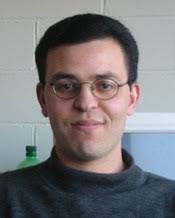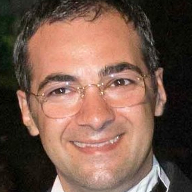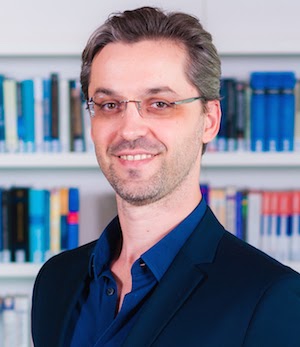 |
Dr. Mourad Oussalah, University of Oulu, Finland
Abstract: Social Network Analysis. Why is it needed? How to do it? What can we expect from it?
In the era of social media and exponential increase of use of social network sites, e.g., Facebook, Twitter, Instagram, professional online communities and networking, social network analysis (SNA) has seen a new birth and new market opportunities. Traditionally, SNA explores the relationship between social entities themselves, examining both the content and patterns of such relationships in order to understand the behavior of the main social actors and predict development of the underlined communities. This talk will explore the background, theoretical concepts and future directions of this interdisciplinary hot topic. We will especially focus on criminology related applications and highlight the contributions of associated disciplines of text mining and social psychology in order to comprehend user behaviors and community development. Particularly, with the availability of large-scale networked data and the development of open data framework, SNA has seen new challenges, which, despite the proliferation of open source tools, new paradigm of big data SNA is emerging. This talk will shed the light on these recent developments and the implications on future criminology research.. |
|
Biography:
Mourad Oussalah is a Research Professor in University of Oulu, Faculty of Information Technology and Electrical Engineering, Centre for Machine Vision and Signal Analysis, where he leads the Social Mining Research Group. Prior joining University of Oulu, he was with the University of Birmingham, UK from 2003-2016. He also held research positions at City University of London and KU Leuven in Belgium, and Visiting Professor position in University of Evry Val Essonnes of France (summer 2006), New Mexico of USA (summer 2009) and Xian of China (Fall 2018). Dr. Oussalah research has concentrated mainly on information and data fusion, text mining, information retrieval and uncertainty handling where he published more than 250 international publications and supervised a dozen of PhD students and more than 40 Msc students, provided more than 20 keynote talks at international conferences and served as PC members of more than 60 international conferences and won best paper awards at IEEE International Conference on Cybernetic Intelligent Systems 2008, WCE, 2015 and best paper nominee at KDIR 2017. He is a Fellow of Royal Statistical Society and Senior member of IEEE and acted as executive of IEEE SMC UK & Ireland Chapter from 2002 till 2016. Dr. Oussalah is also leading and participating into several EU projects including YoungRes (#823701) (2019-2021) on Youth polarization, Prince (#815362) (2019-2022) on CBRNE incidents, Cutler (#770469) on Coastal Urban development, CBC Karelia (Finland-Russia) on IoT Business Creation (2018-2020), Grage –Marie Skłodowska-Curie action (ID:645706) (2016-2018) on active ageing and elderly living in urban settings. He also secured funding from several foundations (e.g., Finnish Cancer Research, Nokia and Nuffield foundations).
|
|
 |
Dr. Anastasia Giachanou, Universitat Politècnica de València (UPV), Spain
Abstract: Misinformation Detection in Online Social Networks using Content Information
Misinformation is considered one of the most critical challenges of recent years. Despite all the attempts, the automatic detection of misinformation still remains an open problem. Although misinformation and fake news exist for a long period of time, the ubiquitousness of social media has facilitated their propagation with severe consequences for the society. For example, the “Pizzagate” shooting incident was a result of fake news that went viral claiming the involvement of a restaurant in human trafficking. This talk will focus on the topic of misinformation detection. First, I will introduce the concept and characteristics of the different types of misinformation and disinformation such as fake news, satire, rumours that go viral in online social networks. Then, I will present some of the most recent detection approaches with a particular focus on approaches that exploit psycho-linguistic information (i.e., emotion, sentiment, informal language). Finally, I will discuss challenges and open issues in the field of misinformation detection. |
|
Biography:
Anastasia Giachanou is a Research Fellow at the Universitat Politècnica de València (UPV) and a member of the Natural Language Engineering Lab headed by Prof. Paolo Rosso. She received her PhD from the Faculty of Informatics at the University of Lugano, in Switzerland working on the topic of “Tracking Opinion Evolution on Social Media”. Her research interests include fake news detection, credibility in news, bot detection, sentiment and emotion analysis, temporal opinion mining and information retrieval. She serves on the editorial board of Information Processing & Management Journal and as a PC member for well-established conferences such as SIGIR, ECIR, CIKM, and ECAI. She is a recipient of an Swiss National Foundation (SNF) early post-doc grant on the project "Early Detection of Fake News on Social Media".
|
|
 |
Prof.L. Alfredo Grieco, Politecnico di Bari, Italy
Abstract: An Information Centric Networking Approach to Publish-Subscribe in mobile IoT systems.
Information Centric Networking emerged more than one decade ago as an alternative approach to the Future Internet, based on name driven networking primitives. Since most of IoT services are information centric by design, the scientific community is actively investigating novel ICN-IoT architectures to circumvent the limitations of host-centric approaches. In this context, it is imperative to evaluate how different ICN architectures cope with Publish-Subscribe approaches with different degree of mobility. Starting from this premise, the keynote will: (i) briefly summarize the key features of the ICN rationale; (ii) introduce the approaches proposed so far to support publish-subscribe in ICN-IoT architectures; (iii) highlight the technical issues that can arise in presence of mobility; (iv) illustrate possible solutions to those issues; and (v) draw future research directions. |
|
Biography:
L. Alfredo Grieco received the Dr. Eng. degree (with honors) in electronic engineering from “Politecnico di Bari,” Bari, Italy, in Oct. 1999 and the Ph.D. degree in information engineering from “Università di Lecce,” Lecce, Italy, on December 2003. From Jan. 2005 to Oct. 2014, he held an Assistant Prof. position at the “DEI - Politecnico di Bari”. From March to June 2009, he has been a Visiting Researcher with INRIA (Sophia Antipolis, France), working on the topic of Internet measurements. From Oct. to Nov. 2013, he has been a Visiting Researcher with LAAS-CNRS (Toulouse, France) working on Information Centric Networking design of M2M systems. From Nov. 2014 to Dec. 2018, he has been an Associate Professor in Telecommunications at Politecnico di Bari (DEI). Since Dec. 2018, he is a Full Professor in Telecommunications at Politecnico di Bari (DEI). He authored more than 150 scientific papers published in venues of great renown that gained more than 6000 citations. His current research interests include: Internet of Things, Information Centric Networking, and Nano-communications. He is the Founder Editor in Chief of the Internet Technology Letters Journal (Wiley) and serves as EiC of the Transactions on Emerging Telecommunications Technologies (Wiley) and as associate editor of the IEEE Transactions on Vehicular Technology (for which he has been awarded as top associate editor in 2012 and 2017). He has been constantly involved as Technical Program Committee member of many prestigious conferences. Within the Internet Engineering Task Force (Internet Research Task Force), he is contributing (as author of RFC 7554) new standard protocols for industrial IoT applications (new standard architectures for tomorrow ICN-IoT systems). Starting from 2016 he is a Distinguished Lecturer for the IEEE VTS. From Jan. 2019, he is Founding Member and Subarea-Chair of the IEEE SIG on Intelligent Internet Edge.
|
|
 |
Dr.Gabriel Maciá-Fernández, University of Granada, Spain
Abstract: Cybersecurity and IoT: open challenges and perspectives.
With the advent of smart cities, smart homes and smart everything, the Internet-of-things (IoT) has become a very active area with an ever increasing impact in industry, education, homes, and current society in general. Due to this importance, IoT has attracted the attention of cybersecurity criminals, that leverage ubiquitous and vulnerable low-cost and low-resources devices to deploy their botnets.
In this talk, we will discuss the main security problems that appear in the IoT deployment nowadays. A review of the most important vulnerabilities and attack strategies will be done, as well as the main existing security solutions. Finally, open challenges and new perspectives will be presented for discussion within the research community.
|
Biography:
Gabriel Maciá-Fernández is an Associate Professor at the Department of Signal Theory, Telematics and Communications of the University of Granada (Spain) and a member of the cybersecurity research group (NESG). He received a MS in Telecommunications Engineering from the University of Seville, Spain, and the Ph.D. in Telecommunications Engineering from the University of Granada in 2007. In the period 1999-2005, he worked as a specialist consultant at Vodafone Spain before joining the University of Granada. His research interests are on computer and network security, with special focus on intrusion detection, reliable protocol design, network information leakage and denial of service. He is currently the head of the cybersecurity master program of the University of Granada and the founder of the hackiit hacking group.
. | |
|
 |
Dr.Davor Svetinovic, Khalifa University of Science and Technology, UAE
Abstract: Blockchain – IoT – AI Trust Nexus.
Blockchain is the underlying technology behind Bitcoin and it is finding its way in the development of a variety of new software systems. With its innovative approach to decentralized computation and assets management, the blockchain has not only potential to solve a number of system scalability, reliability, security, and privacy issues, but also to revolutionize software systems development in a way similar to what the Internet did. For example, the integration of the blockchain, artificial intelligence (AI), and the Internet of Things (IoT) provides a promising new research and development direction that has generated significant research funding and venture capital investments. However, the lack of explanation when it comes to the decisions made by today's AI algorithms is a major drawback with respect to trust in such systems, e.g., deep neural networks do not offer control or reasoning over their internal processes.
In this keynote talk, we present the trust issues common to blockchain – IoT – AI systems and their integration. We present some directions for achieving more trustworthy and explainable blockchain – AI – IoT system integration by leveraging features of blockchain, smart contracts, trusted oracles, and decentralized storage. We discuss a framework for complex AI systems in which the decision outcomes are reached based on decentralized consensuses of multiple AI predictors. Finally, we discuss few key application areas with practical use cases.
|
Biography:
Davor Svetinovic is an Associate Professor at Khalifa University of Science and Technology, UAE, and a Research Affiliate at MIT Media Lab, USA. His primary areas of expertise are software systems engineering and systems security. He received his PhD degree in Computer Science from University of Waterloo, Canada. Previously he worked as a visiting professor and research affiliate at the Massachusetts Institute of Technology (MIT); and as a postdoctoral researcher at Lero -- the Irish Software Engineering Center, Ireland, and Vienna University of Technology, Austria. He leads the Strategic Requirements and Systems Security Group (SRSSG), and he has extensive experience working on complex multi-disciplinary research projects. He has published over 75 papers in leading journals and conferences. His current research interests include systems security, privacy, and trust; blockchain engineering; constrained AI; smart grids energy trading; and cryptocurrencies. He is a Senior Member of IEEE and ACM. | |
|
 |
Dr. Nabil Abdennadher, University of Applied Sciences, Western Switzerland, Switzerland
Tutorial Abstract: Combining Edge and Cloud for smart cities applications
Cloud computing traditionally serves IoT applications by providing storage for generated data, and CPU
power to produce value for their businesses. However, the growth of IoT is affecting the way traditional
cloud architectures work. The increased amount of data to be transferred is creating bottlenecks while
increasing the latency. Furthermore, sending such a big amount of data to a cloud environment in very
short periods of time is inefficient, apart from cumbersome and expensive. This implies that much of
this data must be aggregated at the “end points” where data is collected. And here is where Edge
computing comes in.
Edge Computing is not devised as a competitor to cloud; it is envisioned as the perfect ally for a broad
spectrum of applications for which traditional Cloud Computing is not sufficient. Combining the edge
approach with IoT sensors and Cloud would add flexibility and choices for customers.
This tutorial will answer these questions:
1. What problems does edge computing solve?
2. How can we take advantage of the edge computing?
3. How does edge computing and cloud computing work together?
It will also present current technologies for designing hybrid platforms (edge, cloud) for IoT applications.
The tutorial will also present a generic platform for intelligent IoT applications based on a shareable
backbone infrastructure composed of three layers: IoT objects, edge devices and cloud infrastructure.
Our framework:
• delivers machine learning models (MLM) learned in the cloud over data streams collected by
the edge, from IoT devices.
• supports lightweight learning algorithms that can execute on the edge and self-adapt without
any synchronisation with the cloud
The platform delivers the following functionalities:
1. Coordinate application deployment from the cloud to the edge. The platform will target cloud,
edge and IoT devices. IoT applications can be deployed, configured, operated and maintained,
using a shared infrastructure, where several applications can coexist.
2. Continuously integrate, deploy and maintain MLMs on edge devices. Learning, which requires
considerably more resources, will take place in the cloud and the learned models will be
deployed at the edge. This will considerably decrease the response time and the necessary
bandwidth between the cloud and edge layer, since real-time data processing will take place
close to the IoT devices. With this functionality, the edge triggers the learning process, although
it is performed in the cloud.
3. Use lightweight, yet powerful, machine learning models that can be setup by, and deployed on,
resource constrained devices that are typically used by edge devices. This alternative is
possible for some IoT applications for which the learning process is light enough to run on the
edge. With this functionality, the edge is more autonomous, its intelligence is “improved” locally. |
|
Biography:
Nabil Abdennadher received the Diploma in Engineering (Computer science) from Ecole Nationale des Sciences de l’Informatique (ENSI, Tunisia), and the Ph.D. degrees in Computer Science from University of Valenciennes (France) in 1988 and 1991, respectively. He was an assistant professor at the University of Tunis II from 1992 to 1998 and a research assistant at the Computer Science Department of the Swiss Federal Institute of Technology (EPFL) from1999 to 2000. In 2001, he joined the Department of Computer Engineering at the University of Applied Sciences, Western Switzerland (HES-SO, hepia) as an assistant HES professor. In 2008, he became an associate HES professor and in 2017 he was promoted to full HES professor. He is currently head of both the inIT Research Institute and the Large Scale Distributed Systemsresearch group (lsds.hesge.ch). His major research interests include high performance and distributed computing, Internet of Things and urban computing. Since 2019, he is member of the Swiss Alliance for Data-Intensive Services. He was a member of the Swiss National Grid Association (SwinG) Executive Board from 2008 to 2013.
Nabil Abdennadher participates in several research projects funded by Europe and several Swiss research foundations (InnoSuisse, swissuniversities, Switch AAI, etc.). He is also the founder of two companies in Tunisia and Switzerland.
|
|